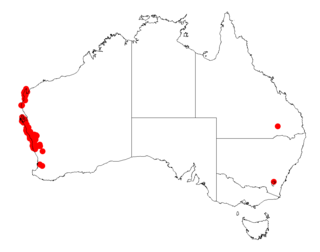
Acacia limbata is a shrub belonging to the genus Acacia and the subgenus Juliflorae that is endemic across northern Australia.

Acacia rhodophloia, commonly known as minni ritchi or western red mulga, is a tree or shrub belonging to the genus Acacia and the subgenus Juliflorae that is endemic to a large area of arid central western Australia. The Indigenous group the Kurrama peoples know the plant as mantaru.

Acacia calcarata is a shrub belonging to the genus Acacia and the subgenus Phyllodineae.

Acacia concolorans is a shrub belonging to the genus Acacia and the subgenus Phyllodineae that is endemic to Western Australia.

Acacia costata is a shrub belonging to the genus Acacia and the subgenus Phyllodineae that is endemic to Western Australia.

Acacia daphnifolia, also known as northern manna gum, is a tree or shrub belonging to the genus Acacia and the subgenus Phyllodineae that is endemic to Western Australia.

Acacia dempsteri is a shrub belonging to the genus Acacia and the subgenus Phyllodineae endemic to south western Australia.

Acacia hastulata is a shrub belonging to the genus Acacia and the subgenus Phyllodineae that is endemic to an area in south western Australia.

Acacia pycnocephala is a shrub of the genus Acacia and the subgenus Phyllodineae that is endemic to south western Australia.

Acacia retrorsa is a shrub of the genus Acacia and the subgenus Phyllodineae that is endemic to western Australia

Acacia rossei, also known as Yellowdine wattle, is a shrub of the genus Acacia and the subgenus Phyllodineae that is endemic to south western Australia.

Acacia scirpifolia is a shrub or tree of the genus Acacia and the subgenus Phyllodineae that is endemic to western Australia

Acacia spathulifolia commonly known as Gold carpet or the Gold carpet wattle is a shrub of the genus Acacia and the subgenus Phyllodineae that is endemic to coastal parts of western Australia.

Acacia sphacelata is a shrub of the genus Acacia and the subgenus Phyllodineae that is endemic to south western Australia.

Acacia eremaea is a shrub or tree of the genus Acacia and the subgenus Plurinerves that is endemic to an area in western Australia.

Acacia tetanophylla is a shrub of the genus Acacia and the subgenus Plurinerves that is endemic to an area of south western Australia.

Acacia cretacea, also known as chalky wattle, is a shrub belonging to the genus Acacia and the subgenus Phyllodineae that is endemic to South Australia.

Acacia saliciformis is a shrub or tree belonging to the genus Acacia and the subgenus Phyllodineae native to eastern Australia.

Acacia saxicola, commonly known as Mount Maroon wattle, is a shrub belonging to the genus Acacia and the subgenus Phyllodineae native to eastern Australia.

Acacia kydrensis, commonly known as Kydra wattle, is a shrub of the genus Acacia and the subgenus Phyllodineae that is endemic to south eastern Australia.





















